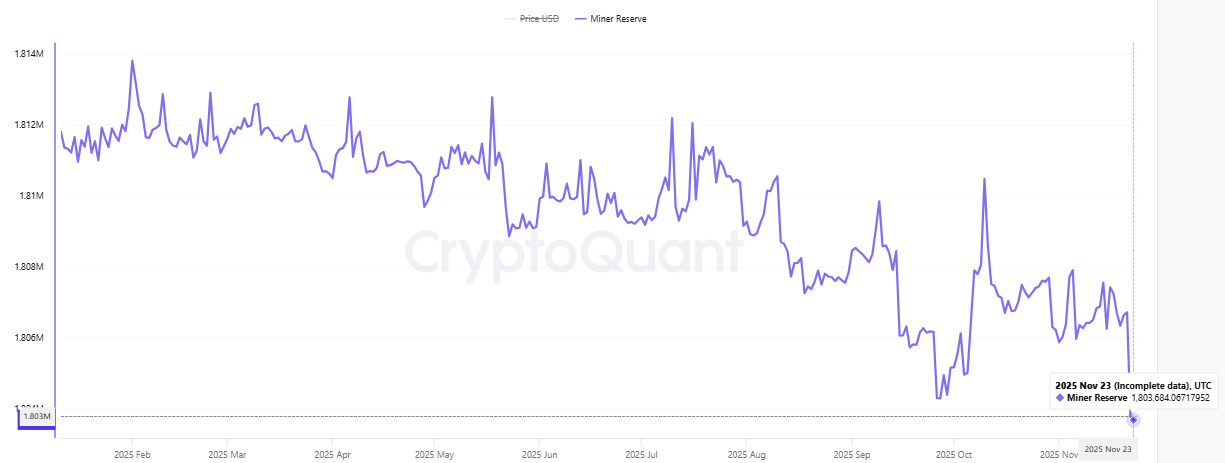Bitcoin Miner Reserves Plunge to Record Low as Revenue Collapses
Bitcoin hashprice has fallen over 50% to an all-time low, leaving most miners operating at a loss while network difficulty remains near peak levels.
Bitcoin miners are aggressively draining their reserves in a bid to shore up balance sheets against a historic collapse in revenue efficiency.
Data from CryptoQuant reveals that miners have transferred more than 30,000 Bitcoin, valued at around $2.6 billion, from their wallets since November 21.
Bitcoin Mining Faces Survival Phase as Reserves Fall to Lowest Level Ever
As a result, the exodus has pulled total miner reserves down to 1.803 million BTC, the lowest levels on record.
 Bitcoin Miners Reserve. Source:
Bitcoin Miners Reserve. Source:
This sudden liquidity event signals that operators are pivoting from accumulation to survival, forced to monetize hard assets to cover operational overhead as cash flows dry up.
The catalyst for the sell-off is a brutal deterioration in mining economics.
According to Hashrate Index data, Bitcoin’s hashprice has fallen more than 50% in recent weeks to an all-time low of $34.49 per petahash per second.
Hashprice is the industry standard for tracking daily revenue per unit of computing power.
 Bitcoin Hashprice Over the Past Year. Source:
Bitcoin Hashprice Over the Past Year. Source:
For context, even during the 2021 China mining ban and the depths of the 2022 bear market, this metric rarely dipped below $50.
The current levels imply that, for all but the most efficient operators, the cost of generating a new Bitcoin now exceeds the asset’s market price.
Compounding the pain is a stubborn disconnect between price and network difficulty. While Bitcoin has corrected 22% over the past month to trade near $86,075, the network’s total computing power has refused to budge.
The global hashrate remains elevated at over one zettahash, suggesting a high-stakes game is playing out across the sector.
This implies that well-capitalized public miners are keeping next-generation fleets online despite negative margins. They are effectively subsidizing production with equity issuance or cash reserves.
The strategy is designed to squeeze out smaller, private competitors who lack access to capital markets.
Considering this, industry analysts warn that if Bitcoin prices do not quickly reclaim their uptrend, the sector could face a prolonged wave of capitulation.
In that scenario, distressed miners may be forced to liquidate not only their Bitcoin holdings but their physical infrastructure as well.
Disclaimer: The content of this article solely reflects the author's opinion and does not represent the platform in any capacity. This article is not intended to serve as a reference for making investment decisions.
You may also like
Astar 2.0 and the Emerging Era of Scalable Blockchain Solutions: Evaluating the Prospects for Institutional Integration
- Astar 2.0 introduces hybrid blockchain architecture and 300,000 TPS scalability to address institutional adoption barriers. - Strategic partnerships with Sony (Soneium) and Toyota demonstrate real-world applications in entertainment and supply chain digitization. - Institutional confidence grows through $3.16M ASTR investment, 20% QoQ wallet growth, and $2.38M TVL amid market downturn. - Staking 2.0 governance and Chainlink/ChainZero integrations enhance security and cross-chain interoperability for ente
Aster DEX Integration and DeFi Sector Placement: Growth Prospects for 2025
- Aster DEX surged to 2M users by Q3 2025 via hybrid AMM-CEX model addressing DeFi liquidity challenges. - Strategic Binance partnership and AI-powered liquidity routing reduced slippage by 40%, boosting institutional adoption. - $10M trading competition and cross-chain capabilities on BNB Chain/Ethereum/Solana drive late-2025 growth momentum. - Faces 63% open interest deficit vs Hyperliquid but outperforms rivals with 19.3% Perp DEX market share and institutional-grade features. - Temporarily delisted fro
The Emergence of DASH Aster DEX: Ushering in a New Age for Decentralized Exchanges?
- DASH Aster DEX introduces a hybrid AMM-CEX model with AI-driven liquidity and ZKP-based blockchain to address DeFi scalability and trust issues. - The platform achieved $27.7B daily trading volume and $1.399B TVL in Q3 2025, attracting both retail and institutional investors through cross-chain liquidity aggregation. - Aster Chain's 10,000 TPS capacity and privacy-preserving ZKP technology position it as a high-throughput competitor to Ethereum and Solana while balancing transparency and confidentiality.
BAT Offsets Zimbabwe Declines with Increased Nigerian Exports and Reduced Expenses
- British American Tobacco (BAT) shares rose 10% amid regional performance divergence and cost-cutting, despite Zimbabwe's 7% cigarette consumption decline. - Zimbabwe operations saw 22% revenue drop but turned $3M loss into $11M profit via cost discipline, while Nigeria's $300M export sales earned industry recognition. - BAT's dual strategy of cost optimization in shrinking markets and export-driven growth in high-growth regions boosted investor confidence and operational resilience. - Nigerian exports su

